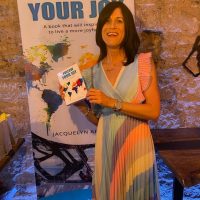On 5th October 2021, my birthday, I achieved a pretty significant milestone in the life of a first time author. My first ever travel memoir, Follow Your Joy, was birthed into the world.
I know it sounds dramatic, but that’s how it felt.
As Scotland entered another lockdown in January 2021, I started to write. 9 months later my book was ready to be shared.
As someone recently expressed, “This is no small achievement”.
I’m fully aware how privileged I am to have my own book available to the world. So many people stumble as the finish line comes into sight, their dream hijacked. I completely understand why and that’s why I want to continue to share my journey.
Recently, I enjoyed my book launch party – it felt like the baby shower for my book. The event that happens prior to the full publication. My friends and family all gathered to see, touch and enjoy my book. I’d kept this thing that started as a side project pretty close to me. It was now, well, out of my hands and into others. It all feels very surreal.
It has been a rollercoaster ride and I survived it, just. Now I want to share what I learned along the way. My achievement is, I hope, the inspiration for the next writer. I want this post to create a ripple!
1. Find your Audience
Get comfortable explaining your book concept and develop your pitch. Who would buy your book? What do you want to share with them? What does a 5 star review read like from your audience?
Get in their shoes and think of them as you write. Your audience will become your why as only by publishing your book do you hand them your gift – your words and wisdom need to be shared.
I had a few readers in mind for my travel memoir:
A. Those who will never travel to far flung places but want to experience what I have. My book will provide the ultimate travel escapism.
B. Those who are curious and may need a little nudge to get out into the world. My book is that nudge as I tell tales from exotic places that are accessible to all.
C. Those who have travelled and love the vibrancy of following another travelling soul. My book is a little insight into my world, to deliver some of the travel inspiration I’ve gained over the years. Ready to pass onto the next traveller.
D. Those who may feel a bit lost in life and need inspired to take a leap. My book is your inspiration. Life is way too short to ponder on all the ‘what if’ scenarios?
E. Those who say yes to living a life on their terms. This book will continue to validate your dreams can become your reality.
2. Identify what is unique about you or your book?
This will become your marketing ‘Unique Selling Point’ (UPS). Get familiar with your book genre. Visit a bookshop and look at your fellow genre writers. They have achieved what you want, so use them to inspire you. Grab their books, feel them in your hands and visualise your book alongside them. In a world of abundance, there is room for YOU. So get writing.
My UPS: I have travelled to 90 countries, mainly solo. My book is the product of 90 countries worth of experiences achieved on my terms. No one else can boldy state that.
3. Develop a daily practice
Start writing then don’t stop until you have written a book. Just start, today, now, as soon as possible, then don’t stop. Start today. Commit to at least one 25 minute session each day – no excuses – then once you start you will be surprised how that one session turns into multiple. Or at least you will have written one session minimum each day.
You will soon find your flow. Once in flow don’t wish this away, we seek the flow state. Embrace it.
Tip: The technique I use is called Pomodora. You write in chunks of 25 minutes with a 5 minute break. The key is to switch your phone to airplane mode so the five minute break doesn’t turn into a social media distraction. Stretch your legs, make a cup of tea or grab a snack. Then get back into the next 25 minute session.
4. Reset
Writers block only exists if you stay stuck, stopped in your tracks. When I felt it, I would walk away from my desk and laptop. But not for long. I would jump on my bike with a playlist or podcast playing to free my mind. Cycling surrounded by nature. Movement, nature and inspiration ringing in my ears, any blocks would soon be flushed out.
Or I would run, along the canal or river, with music playing, soon interrupted by my creative thoughts. All rising from my soul. The next time I I sat at my desk I would feel lighter but full; lighter from the release and full with ideas.
Develop your own reset practice. Don’t stay stuck and don’t get frustrated. Remember this is part of the creative process. Flow with it.
5. Embody the author lifestyle
Think of your favourite author. How would they set up their environment and day? ‘Being an author’ is a way of life not a fad or one off thing. It is a commitment to the creative practice that should fill your soul. I religiously listened to the podcast hosted by my favourite author, Emma Gannon. Her books have inspired my writing. I bought a bright yellow desk where I would sit in my spare bedroom surrounded by my travel memories – photos and trinkets from my favourite destinations. I would sit perched with a cup of tea and slice of dark chocolate wearing a chunky jumper, I started to write in the Scottish Winter, or a comfy hoody as winter turned to Spring. I would listen to the same playlist on repeat, this trained my mind to flow. I was a writer the minute I stepped into the environment I had set.
6. Visualise your book
Visualise your book front cover, your ‘About the author’ page, the back cover blurb. Visualise your book in bookshop shelves, online and in people’s hands. On their coffee table, bookcase, or bedside table. Bring your book to life and feel the excitement. Open up all your senses to it becoming real.
When I first saw my book design I felt this surge of excitement. It felt real and I was excited, very excited. I wanted to bottle up this feeling and pass it on.
7. Be mindful of your mindset
The journey is not linear. You will face bumps and hurdles. Obstacles will get in your way and it is your job to remove the obstacle. I will let you into a secret. You, most of the time, are the gatekeeper to the obstacles. You placed them there or welcomed them in. It is your job to acknowledge them, sit with them then send them away. Learn from them, but don’t stay stuck.
What will the obstacles look like?
1. Self Doubt / Comparison – “ My work isn’t good enough” “What am I even thinking, no one will read this book. I am not as good as <<insert author>>”
2. Self Sabotage – “I don’t believe in myself and want to quit when it all feels good”
What If? – “What if there are errors in my work”
When you feel the doubt, comparison or self-sabotage behaviour creep in use your network of close advisors to chat through how you feel, what you fear or are (over) thinking. Then develop a plan to remove the obstacle.
Sometimes just saying it out loud removes the energy from the story playing out in your head.
8. Keep inspired – your why
Remember your why. This will motivate you and inspire you to keep showing up. Keep typing on that keyboard. My number one why is my niece and nephew. I think of them one day reading my book and feeling the urge to explore this amazing world. Also the thought that my tales have been shared into the world to inspire others kept my focus.
This book will be delivered to the British Library – my legacy. How awesome is that! It will outlive me.
9. Detach from the art and deliver a product
There is a moment when you need to step back from your words, your art, your work and release it into the world. Transfer it into a product that is ‘shippable’ otherwise we suffocate it and watch it sit on our laptops to then fade away into nothing. A book doesn’t thrive in a laptop, it thrives online or in a bookshop.
My advice here is to practice non attachment. This book is your work, but will not serve any purpose to the world unless you deliver it – like a baby, screaming into the world “I’m here, look over here”. Set your work free.
10. Press the trigger – Publish that book
There is no point looking at the ‘publish a book’ finish line and pressing the game over button.
The game hasn’t even really started, that happens the minute you publish the book. I know. I am playing that level of the game now. The amazing comments arrive from family and friends – I smile as I think “They are reading my words”. A book launch party is waiting around the corner for you, my launch party was so joyful. Then when you see your book online in ebook and paperback form – that is next level excitement. People sharing screenshots of their purchase – eek. Their excitement becomes your excitement, and you smile as you remember what you visualised earlier in the process. Your vision has become your reality – your book is sitting on peoples coffee tables. My book has even been on holiday to Croatia. It is two weeks old as I type this.
My final share – Just Do It, it is exhilarating!
I promise you. I know, I did it!
‘Follow Your Joy’ is available online in paperback and ebook form. It is my gift back into the world that is my playground.
Useful Resources
- 30 day Challenge found here. Joshua Sprague provides emails each day for 30 days to guide, motivate, and educate you. Labelled: How To Write Your Non-Fiction Book In The Next 30 Days
- The Book You Were Born to Write: Everything You Need to (Finally) Get Your Wisdom onto the Page and into the World found here
- Successful Publishing- Joanna Penn found here
- The Practice – Seth Godin found here
- The Artist’s Way – Julia Cameron found here
- Creative Rebels podcast found here
- Emma Gannon podcast found here
- IngramSpark blog found here











Read 0 comments and reply